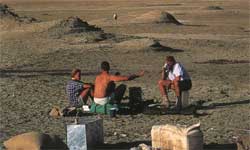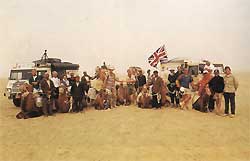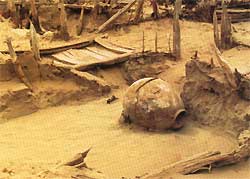
Day
01 Cross
the Tuogart Pass and transfer to Kashgar. Check in your hotel
Day 02 Free day in Kashgar. The old city, once
known as Kashi, is an exotic Central Asian trading oasis unrivalled
anywhere in the Chinese and Soviet Empires. Despite its situation
between the awesome physical barriers of the Tien Shen, Pamir
and Karakoram Mountain ranges, this town was the meeting point
of at least four of the main Silk Road arteries. Over the years,
the collision of cultures between the Pakistani's, Kirghiz,
Soviet and Chinese has helped Kashgar to flourish. Even today,
a stroll around one of Kashgar's numerous bazaars will take
you back in time, as you mix with the throngs of traders and
their livestock. Muslim Uighurs, who account for 90 percent
of Kashgar's population, are the dominant ethnic group that
you will encounter in Kashgar's thriving town centre. At the
same time, the Chinese continue their efforts to change Kashgar
into a modern town with an airport, ring road and numerous bars
and nightclubs. To spend a day in Kashgar is a not only a delight
but a wonderful insight into the color ful way of life of the
peoples of Central Asia. Altitude at Kashgar: 1205 metres.
 Day
03 Leave Kashgar, the typical Uygur city and towards
to Khoten. Stop at Yarkand for 2 hours in order to visit the old
part of this town where used to be a important station on the
Marco Polor Route. When you walk in this old part, when you watch
these local men who are making some handcrafts with super and
old skill in wood carving, I am sure you will feel as if you were
back to hundreds of years ago. I am sure you never believe such
old techniques are still used today in this part of the World
if you are not here. Then after your short but remarkable trip
in this old town, you have to continue your journey to Khotan.
When you arrive there in the late evening, check in your hotel
and stay for night there. The distance today is about 550 kilometers,
highway. Day
03 Leave Kashgar, the typical Uygur city and towards
to Khoten. Stop at Yarkand for 2 hours in order to visit the old
part of this town where used to be a important station on the
Marco Polor Route. When you walk in this old part, when you watch
these local men who are making some handcrafts with super and
old skill in wood carving, I am sure you will feel as if you were
back to hundreds of years ago. I am sure you never believe such
old techniques are still used today in this part of the World
if you are not here. Then after your short but remarkable trip
in this old town, you have to continue your journey to Khotan.
When you arrive there in the late evening, check in your hotel
and stay for night there. The distance today is about 550 kilometers,
highway.
Day 04 Switch your bus into jeeps and leave for
Kerriya (Yutian County) in the morning.. It takes 4 hours by driving
to get Kerriya, then do some short visiting before your lunch
here. You continue your driving northwards into Taklamakan, following
the Kerriya River and passing over several villages in this remote
area, you will set up your first camp at the foot of a beautiful
sand mountain.
 Day
05 The final day of driving takes us across a sandy landscape,
punctuated by stands of poplar trees, stunted pine and scrubby
bush. It is hot and dusty drive to the last settlement in the
valley, Tongguzbasti, where we set up camp. About 50 families
manage to sustain their meager existence in this remote outpost. Day
05 The final day of driving takes us across a sandy landscape,
punctuated by stands of poplar trees, stunted pine and scrubby
bush. It is hot and dusty drive to the last settlement in the
valley, Tongguzbasti, where we set up camp. About 50 families
manage to sustain their meager existence in this remote outpost.
Day 06 day for sightseeing in and around this
unusual desert village. Most of the genuine desert families live
away from the village and we will take the opportunity to go out
to visit some of them. There are some brick-built dwellings and
a school and village hall at Tongguzbasti but, generally, the
living conditions in this harsh corner of the world are very primitive.
Most of the houses are constructed on a light wooden frame with
lattice and mud walls and roofs. It is unusual for the houses
to have any furniture or ornamentation of any sort, save for rudimentary
cooking equipment. The people of this village have been called
"the lost tribe of the Taklamakan."
Day 07 Today, you set off trekking into the desert,
accompanied by your Uighur camel drivers and their animals. Heading
westwards, for the first 3 hours or so, we encounter some low
trees and bushes and then we begin to walk between the sand dunes.
Each day, we aim to establish camp in the late afternoon, leaving
plenty of time to relax and enjoy the sunset and to sit around
the campfire gazing at the unbelievably bright stars.
 Day
08 The dunes become bigger as we head west and there
is now very little vegetation. Trekking on the soft sand dunes
is hard work and our rate of progress becomes slower.. By lunch
time on this second day, we reach the ancient ruins of Karadong.
After lunch, we spend half a day exploring what was once an important
staging post on the Silk Road. There are many buildings buried
by sand, but some of them have been uncovered by the desert wind.
We camp at Karadong. Day
08 The dunes become bigger as we head west and there
is now very little vegetation. Trekking on the soft sand dunes
is hard work and our rate of progress becomes slower.. By lunch
time on this second day, we reach the ancient ruins of Karadong.
After lunch, we spend half a day exploring what was once an important
staging post on the Silk Road. There are many buildings buried
by sand, but some of them have been uncovered by the desert wind.
We camp at Karadong.
Days 09/12 During the next five days, we will
settle into the rhythm of long trekking days on the pristine wave-like
dunes. Day after day, the camel train climbs to cross a succession
of sand mountains which are 60 to 70 metres high. On a couple
of occasions we find salt-crusted surface formations which indicate
the presence of water close underground. The camel drivers will
dig down into these hidden reservoirs and spend long hours in
the evening, watering the camels. The surreal beauty of the desert
and the pleasant evenings around the campfire will provide memories
to last a lifetime. On the fifth day, we should catch the first
distant glimpse of a black line on the western horizon, which
marks the location of the only rock formation in the Taklamakan,
Mount Mazartagh.
Day 13 A final morning in the dunes brings us
ever closer to Mount Mazartagh, which lies adjacent to the dry
valley of the Hotan River. After a picnic lunch, we reach the
Hotan river flats, which are covered by dense stands of gnarled
trees, and it then takes a further 2 hours to reach our camping
place at the foot of the rock ridge. On the crest of this 150
metre-high red sandstone hill are the ruins of a small fort, dating
from the 8th or 9th Century AD. These ruins were first excavated
by the explorer Aurel Stein in 1908. Before dinner, we can make
the climb up to the site of the fort and look back across the
desert at the sea of low, horse-shoe-shaped dunes which we have
crossed.
Day 14 Meeting up with our transport, we start
the drive out of the desert, heading north along the river bed.
Before sun goes down, we set up our last camp in the desert. In
this area, there are wild pigs in the forest of the river valley.
Day 15 After a further 5 hours' driving, we reach
the first greenery that we have seen for over a week. More and
more farmland and villages appear en route to the junction of
the Khotan and Tarim rivers. Finally, the expedition arrives at
Aksu, where we check in to the Friendship Hotel. After the first
priority (luxuriating in a hot bath), we will have a celebratory
evening meal.
Day
16 Switch transport from jeeps to a bus and leave for
Kuche. Stop for 2 hours on the way to visit one of the biggest
and most famous Buddha Caves in China, Kizil Buddha Cave. Check
in a hotel in Kuche in the evening
Day 17 Start early and visit Subashi ancient
ruin before the Sun Rising. It takes you 4 hours to explore in
this ruin and then leave for Kurla. Check in a hotel in the evening
Day
18 Leave for Turfan and check in a hotel in Turfan in
the evening. Enjoy the local singing and dancing performance under
grape trees at night
Day 19 This is a lazy morning, but if you want
to see how the Chinese people do their morning exercises, you
should have to get up early and go to the Peoples¡¯ Square. Then
you will see: some people playing Taiji Boxing, some people playing
Beijing Opera, some people dancing, some people playing, the Yang
Ge, a kind of traditional Chinese dancing ¡Leave for the Heavenly
Lake, the ¡°jewel in the crown¡± of the nearby Mt.Bogda (5445
meters), the highest peak in the east part of Tian Shan mountains.
The altitude of the lake is about 1900 meters above the sea level.
The driving takes 2 hours to get there. Go and visit some local
Kazak families in the yurts in the forests. Lunch is arranged
in the yurt and shared with this local family. Take a boat trip
on the lake in the afternoon. Come back to Urumqi and it takes
you 2 hours to visit the Xinjiang Historical Museum, which you
worth to visit ! Then climb up to the top of the Red Hill to get
a bird views of this whole city. After all today, I suggest you
to take a look in the biggest Night Food Market.
Day
20 Free in Urumqi and Take the flight XO717 flying to
Bishkek at 0805 in the morning. All the services end in the Chinese
part. Our best partner, ITMC Tien-Shan will take a good care of
you in not only in Bishkek but all over Kyrgyzstan.
|